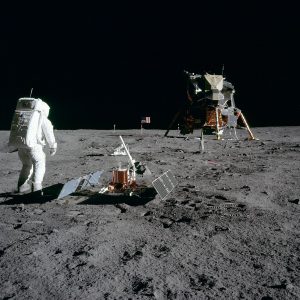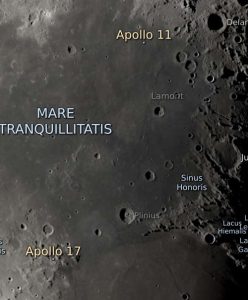
First, the bad news. Even with a large telescope, it is impossible to directly view the equipment left behind on the lunar surface by the first astronauts to walk on the Moon. The next best thing is to look at images such as those taken by NASA’s Lunar Reconnaissance Orbiter of the Apollo 11 lunar landing site from lunar orbit
| January 2024 | April 2024 | July 2024 | October 2024 |
| February 2024 | May 2024 | August 2024 | November 2024 |
| 16 March 2024 | June 2024 | September 2024 | December 2024 |
However, if you have a small telescope, you can locate the region where the Apollo 11 and Apollo 17 astronauts walked on the Moon. You will need to look at the right time of the lunar month. If you look too early, that part of the Moon’s surface will be still in darkness. Look too late and the craters needed to visually locate the landing sites will be hard to locate. The ‘just right’ time is when the Sun is low enough in the lunar sky that the shadows made by the craters around the landing sites are visible.

Almost finally (!), you will want to have a Moon map you can use at your telescope eyepiece. This could be a free one you can download from Sky & Telescope magazine (the site might require free registation first). Other alternatives include a moon chart app for your tablet and phone. The advantage with the latter is than you the app will show you what the Moon likes like at the time you are viewing it. This is really important as the changing angle of the Sun affects how look the lunar crater shadows are on the Moon. This means that lunar features can range from being invisible (if the Sun hasn’t risen for that part of the lunar surface) through to being easier to recognise once it has shadows.
Another option is using the NASA Scientific Visualisation Studio animations generated for each year that show the exact appearance of the Moon (as seen from Earth) for a given time. An extra bonus is you can specify which hemisphere you are located in. This is important given the Moon appears unside down as seen from the Northern hemisphere! The Southern hemisphere 2024 Moon phase animation can be found here.
Finally, it is highly likely that your actual view of the Moon through your telescope will be orientated differently to the Moon chart you use. Your view may be upside down, mirrored or even a combination. An excellent article about ‘why’ is on the BBC Sky at Night Magazine website.